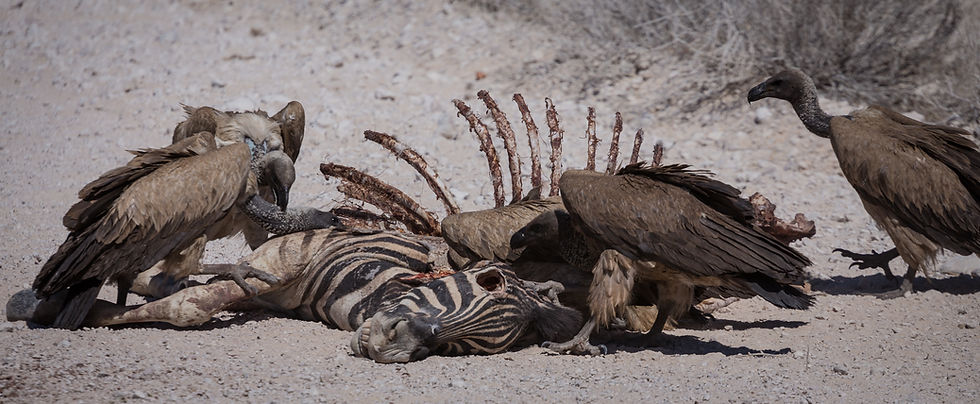
Vultures, worms, flies, bacteria, fungus. How many of us really like them or even read about them? Many of us dislike them because they may appear unpleasant to look at and are associated with smelly, decaying, or dead organisms. Most of them are found in dark, damp, and unhygienic corners. Yuck! But wait! Have you stopped to think about why these scavengers and decomposers are on our planet and what their roles are? Read on to find out!
There are so many fascinating details that encompass scavengers and decomposers. Therefore, to make the subject concise and more appealing to read we will split this topic into two halves. First, in our Part 1 blog, we will start our job by speaking only about scavengers of the wild in this blog. This is because, in nature, the scavengers are the first cleaning crew to arrive at any death scene. Then, after the scavengers have done their task, the so-called decomposers take over, who complete the job. Therefore, in our next blog, coming up next month, we will talk about the decomposers.
So…What are Scavengers?
A scavenger is an organism that mostly consumes decaying biomass, such as meat of a dead or decaying animal called carrion or rotting plant material. Among birds, vultures are the easily recognizable species as scavengers. They are obligate or compulsive scavengers of nature with a great sense of smell. For instance, a turkey vulture can detect a carrion from more than a mile. Vultures are the only members of the animal kingdom that scavenge for food. Furthermore, they are mostly the first large species to arrive at a death site to eat the dead or decaying animal or bird very quickly. Among animals, hyenas and jackals eat carrion from time to time, although they are also known to hunt.

What happens at a death site?
At a death site, depending on the habitat, large predators such as a lion or a tiger eat the meat of the dead animal first. Very soon, all that remains of the carcass are scraps of meat sticking to the bones and some pieces fallen to the ground. The process and rate of scavenging in each habitat depends on the size of the carcass, temperature, and season. It may take an hour or less to several hours for the scavengers to do their job. The types of scavengers found in the region depend on live prey abundance.
In a study carried out in Kluane National Park and Service, Yukon, Canada, it was observed that 24 different species of animals and birds visited dead animals deliberately placed in the habitat for study. The Canadian lynx, red squirrels, and even snowshoe hares were the most common mammal scavengers. Apart from these animals, ravens, Canadian jays, magpies, goshawks, and bald eagles swarmed the carcass followed by black bears, grizzly bears, and wolverines! Wow! The study also showed that the scavengers devoured the carcass faster on warmer days. The reason being that during the warmer season the smell of the carcass travels farther attracting a wide variety of scavengers. Also, many scavengers are not able to dig out buried carcass in the snow or break down the frozen meat. The study also found that many species such as the lynx did not eat the dead meat if prey, such as horseshoe hares, were available in plenty.

Why Are the Scavengers Important?
The scavengers, no matter the size, not only control the population of live animals but also dispose of the dead. This is the vital role they play on our planet.
Stay Tuned!
Ok. So, the scavengers have done their task and have left the death site. Next, the decomposers take over the remains. And that is what we’ll talk about in the next blog!

Did you know?
·Ecological Food chain and food web
In every type of ecosystem, there exists what is called an ecological food chain. It is a representation of linear sequence of organisms that eat one another so that energy and nutrients flow from one to the next. This simplified situation can be diagrammed like a pyramid. In this hypothetical pyramid there can be several steps, each layer called a trophic layer. The bottommost layer is often labeled the “decomposer” layer. The next higher level is called a “producer” level which consists of organisms like grass and trees which use sun’s radiation to produce food through photosynthesis. Higher than this level is the “consumer” level comprising of animal(s) that eats (eat) the grass and such, generated by the producer(s). For example, a deer. And finally, at the top is the “apex predator” level that is filled with animals like a tiger that eat the consumers. When all these organisms consume food and excrete, they are food for the decomposers. In this fashion, the cycle of life goes on. It has been going on since earth was formed about 4.5 billion years ago!
Since an organism which eats another organism can also be eaten by yet another organism, the simple food chain does not describe the situation in real life adequately. Hence a food web. A food web, which is more complex, shows relationship between various organisms in a habitat.
Kids can learn more fun animal and Earth facts with our products!
100% of our annual net profits go to schools and wildlife organizations. You can also support our mission by donating any amount!
Comentários